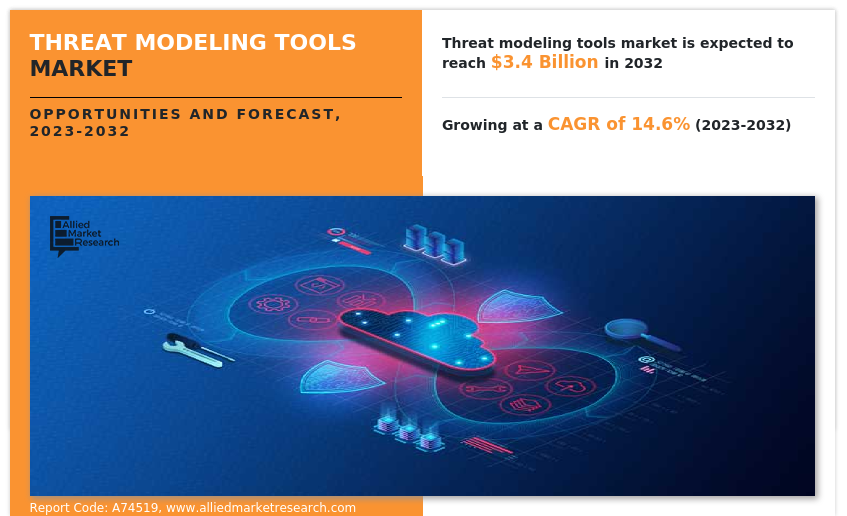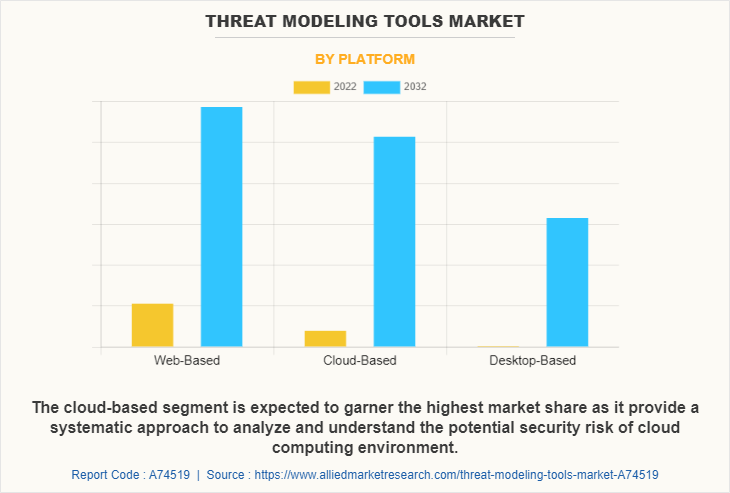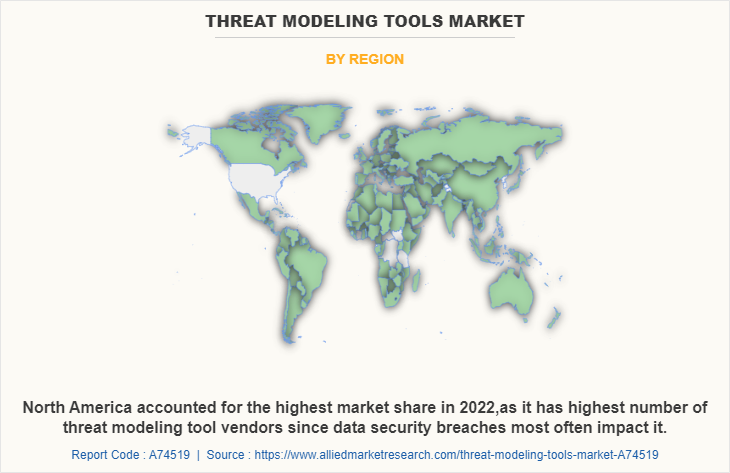Threat Modeling Tools Market Statistics, 2032
The global threat modeling tools market size was valued at $886.6 million in 2022, and is projected to reach $3.4 billion by 2032, growing at a CAGR of 14.6% from 2023 to 2032.
Increase in demand for user-friendly threat modeling tools and rise in implementation of artificial intelligence (AI) in security solution boost the global threat modeling tools market growth. In addition, increase in use of digital transformation technology is positively impacting growth of the threat modeling tools market. However, lack of skills and trained security analyst and high procurement costs of threat intelligence solutions hamper the market growth. On the contrary, rise in adoption of cloud and IoT technologies is expected to offer remunerative opportunities for expansion of the threat modeling tools market during the forecast period.

Threat modeling tool is a software solution that automates the process of identifying and assessing potential threats to a system or organization. In addition, it includes features such as templates for creating threat models, methods for identifying & categorizing threats, methods for evaluating the likelihood & impact of threats, and reporting & visualization capabilities. Moreover, these tools can be used by security professionals, developers, and other stakeholders to identify and prioritize potential security issues and make more informed decisions about how to mitigate or respond to them.
The global threat modeling tools market is segmented into component, deception stack, enterprise size, industry vertical, and region. On the basis of offering, the market is categorized into solution and service. By platform, it is fragmented into web-based, desktop-based, and cloud-based. Depending on enterprise size, it is bifurcated into large enterprises and SMEs. By industry vertical, it is classified into BFSI, healthcare, IT & ITES, utilities, and others. Region wise, the market is analyzed across North America, Europe, Asia-Pacific, and LAMEA.
In terms of platform, the web-based segment holds the highest threat modeling tools market share, owing to the fact that organizations may undertake threat modeling remotely and from different places web-based segment is expected to grow at the highest rate during the forecast period, owing to constantly changing threat landscape that creates new attack surfaces regularly, thus increasing the risk in systems and apps However, the cloud-based segment is expected to grow at the highest rate during the forecast period, due to cloud-based threat modeling solutions, which are hosted on the cloud and accessible through a web browser or API. These technologies, which are often subscription-based, provide cloud-based infrastructure’s scalability, dependability, and security advantages.

Region wise, the threat modeling tools market size was dominated by North America in 2022. The region is expected to retain its position during the forecast period owing to rise in adoption of advanced technologies and increase in government support for emerging technologies. Asia-Pacific is expected to witness significant growth during the forecast period owing to rise in complex attacks and the associated costs.

The key players that operate in the threat modeling tools industry are Cisco Systems, Inc., IBM Corporation, Synopsys, Intel Corporation, Varonis Systems Inc., Microsoft Corporation, Mandiant, Coalfire Systems, Inc., Kroll, LLC., and Sparx Systems Pty Ltd. These players have adopted various strategies to increase their market penetration and strengthen their position in the threat modeling tools industry.
Top Impacting Factors
Increase in demand for user-friendly threat modeling tools
The demand for user-friendly threat modeling tools has been witnessed to increase significantly as they are easy to use for non-experts and straight forward to use. Moreover, threat modelling tools have a clear and intuitive user interface and offer step-by-step instructions for building and assessing threat models, In addition, threat modeling tools includes built-in templets for common threat modeling scenarios, and can easily import and export data. Moreover, threat modeling tools in organizations will collaborate and share threat models with other team members and simplify integration with other security tools and systems, which, in turn, drives the growth of the threat modeling tools market.
Furthermore, it comes with built-in templates for typical threat modeling situations. This will assist in simplifying the threat modeling process and increase user efficiency. Moreover, due to technological advancements across the world and rise in demand for threat modeling tools, various companies have expanded their current product portfolios and innovations with increased diversification among customers. For instance, in September 2022, ThreatModeler launched ThreatModeler 6.0 that represents a complete redesign of the platform’s interface, workflows, model building, and reporting based on feedback collected from users over time. This platform provides a common language to enable developers and security teams to better communicate and also the primary goals of this update is to make threat modeling easy for developers by adding more powerful features to accomplish a variety of tasks on a single platform.
Rise in implementation of artificial intelligence (AI) in security solution
The implementation of artificial intelligence (AI) in security solution is becoming essential to ensure security, as these technologies are capable of swiftly analyzing millions of data sets and tracking down a wide variety of cyber threats. In addition, threat intelligence provides contextual and actionable advice on cyber threats targeting the organization. Furthermore, integrating AI allows deeper insight and ensures scalability as attack volumes increase. It has become an important information security technology as AI quickly analyzes loads of events to identify threats, heighten security, and enhance incident response. Due to the above factors, security leaders are investing in AI.
For instance, according to a survey conducted by Centrify in 2020, 64% of security leaders believe that AI lowers the cost of detecting and responding to breaches. In addition, 69% of enterprises see AI as a necessary investment for responding to cyber-attacks. Moreover, around 51% of executives see cyber threat detection as the primary use case of AI. Therefore, built- in AI security characteristic is one of the key factors driving the growth of the threat modeling tools market.
Digital Capabilities
Threat intelligence framework is a central repository for managing, detecting, and alerting users of potential threats. In addition, these tools use a variety of technologies to analyze and identify potential security risks in IT system and application. Some of the key technologies used in threat modeling tools includes data analysis & visualization, machine learning, and artificial intelligence. Some threat modeling tools use machine learning and AI algorithms to analyze large volume of security data and identify potential threats and vulnerabilities.
Moreover, attack simulation and modeling many threat modeling tools use attack simulation and modeling techniques to simulate real world attack scenarios and identify potential weaknesses in IT systems and application, cryptography, and encryption. This technique is helpful to secure sensitive data and prevent unauthorized access to IT systems and applications. Some threat modeling tools use code analysis to identify potential vulnerabilities and security flaws in software code. Furthermore, many modern threat modeling tools use cloud computing technology to provide scalable and secure hosting environments for threat analysis and modeling.
Key Benefits
Threat modeling functions by identifying various threat agents that pose risk to a computer system or application. Organizations thoroughly examine the software architecture, business environment, and other artifacts while completing threat modeling, for instance, functional specifications and user documentation. They may have a deeper grasp of and uncover essential facets of the system owing to this method. To discover vulnerabilities and understand the security significance of their design, coding, and configuration choices, businesses often finish threat modeling at the configuration stage of a new application (although it may arise at other phases).
In addition, in protecting a single highly classified material, threat modeling attempts to identify, convey, and interpret dangers and their easing through time. An organized representation of all the data that affects the application’s security might be a threat model. A security-focused reading of the application is being done. In addition to software systems, apps, networks, distributed systems, Internet of Things (IoT) devices, and business processes, threat modeling is often used in various contexts.
End-user Adoption
With an increase in competition, major threat modeling tools market players have started partnering with companies to expand their market penetration and reach. For instance, in February 2023, Mandiant partnered with Nucleus, a U.S.-based developer of vulnerability management software. Integrating Nucleus’ analytics and vulnerability management orchestration abilities with Mandiant Advantage Vulnerability Intelligence, the vulnerability prioritization and triage process can be advanced. Further, this partnership advances Mandiant’s potential to serve and support the organization to advance security and risk decision-making. For instance, in September 2021, Synopsys entered into a partnership with The Chertoff Group, a U.S.-based global advisory firm. The partnership focuses on integrated threat modeling, on-time cyber policy insights, technical testing, and validation outcomes.
Owing to technological advancements across the world and rise in demand for threat modeling tools, various companies have expanded their current product portfolios and innovations with increased diversification among customers. For instance, in March 2022, IriusRisk launched its Open Threat Model (OTM) Standard under a Creative Commons license. The OTM Standard, released as part of version 4.1 of the IriusRisk product, is a tool agnostic way of describing a threat model in a simple to use and understand format.
Moreover, with increase in competition, major threat modeling tools market players have started acquiring companies to expand their market penetration and reach. For instance, in July 2021 Microsoft acquired RiskIQ, a U.S.-based developer of a digital threat management platform. The addition of RiskIQ’s team and technology enables Microsoft to better take care of the needs of mutual customers.
Key Benefits for Stakeholders:
The study provides an in-depth analysis of threat modeling tools market forecast along with current trends and future estimations to explain the imminent investment pockets.
Information about key drivers, restraints, and opportunities and their impact analysis on threat modeling tools market trends is provided in the report.
The Porter’s five forces analysis illustrates the potency of the buyers and suppliers operating in the industry.
The threat modeling tools market analysis from 2023 to 2032 is provided to determine the market potential.
Threat Modeling Tools Market Report Highlights
| Aspects | Details |
| Market Size By 2032 | USD 3.4 billion |
| Growth Rate | CAGR of 14.6% |
| Forecast period | 2022 - 2032 |
| Report Pages | 280 |
| By Component |
|
| By Platform |
|
| By Enterprise Size |
|
| By Industry Vertical |
|
| By Region |
|
| Key Market Players | Microsoft Corporation, Mandiant, Intel Corporation, Varonis Systems Inc., Coalfire Systems, Inc., Kroll, LLC., Sparx Systems Pty Ltd., Synopsys, IBM Corporation, Cisco Systems, Inc. |
Analyst Review
Threat modeling is the process of identifying and sharing information about cybersecurity threats that can affect a given network or system. Modeling security threats helps IT teams understand their nature and potential impact on the organization. It also facilitates the analysis of threats to determine their risks to the organization’s apps. In addition, to protecting applications and networks, threat modeling can help protect business-critical processes and assets deployed outside the corporate network, such as cloud systems or Internet of Things (IoT) devices.
The global threat modeling tools market is expected to register high growth due to the adherence to strict regulatory compliances and the widespread availability of customizable threat modeling tools are expected to drive industry growth. Thus, increase in adoption of threat modeling tools, owing to its security is one of the most significant factors driving the growth of the market. With surge in demand for threat modeling tools, various companies have established alliances to increase their capabilities. For instance, in May 2022, Securonix partnered with Mphasis, an India-based provider of IT solutions. The partnership combines Securonix’s analytics-driven detection and automated response tools, and Mphasis’ digital & cyber defense expertise to deliver cyber threat monitoring and response services to customers globally.
In addition, with further growth in investment across the world and the rise in demand for threat modeling tools, various companies have expanded their current product portfolio with increased diversification among customers. For instance, in March 2022, Coalfire launched AppSec solutions. The new solution includes program development and implementation, secure code review, application perimeter mapping.
Moreover, with increase in competition, major market players have started acquisition companies to expand their market penetration and reach. For instance, June 2021, Microsoft completed the acquisition of Miburo, a US-based provider of cyber threat analysis and research services. The addition of Miburo perfectly aligns with Microsoft’s aim to take action and partner with others in the private and public sectors to discover long-term solutions.
The threat modeling tools market is estimated to grow at a CAGR of 14.6% from 2023 to 2032.
The threat modeling tools market is projected to reach $ 2,115.95 million by 2032.
Increase in demand for user-friendly threat modeling tools and rise in implementation of artificial intelligence (AI) in security solution boost the growth of the global threat modeling tools market. In addition, increase in use of digital transformation technology is positively impacting growth of the threat modeling tools market.
The key players that operate in the threat modeling tools market are Cisco Systems, Inc., IBM Corporation, Synopsys, Intel Corporation, Varonis Systems Inc., Microsoft Corporation, Mandiant, Coalfire Systems, Inc., Kroll, LLC., and Sparx Systems Pty Ltd. These players have adopted various strategies to increase their market penetration and strengthen their position in the industry.
The key growth strategies of threat modeling tools market players include product portfolio expansion, mergers & acquisitions, agreements, geographical expansion, and collaborations.
Loading Table Of Content...
Loading Research Methodology...



